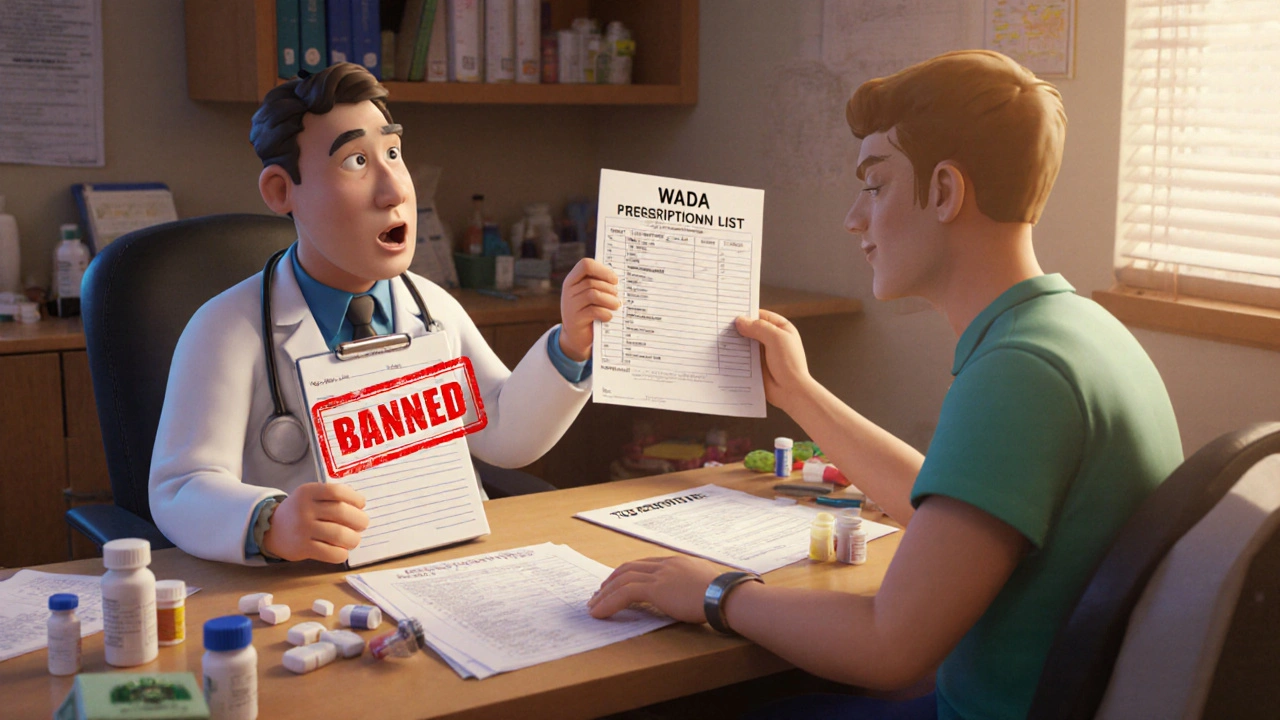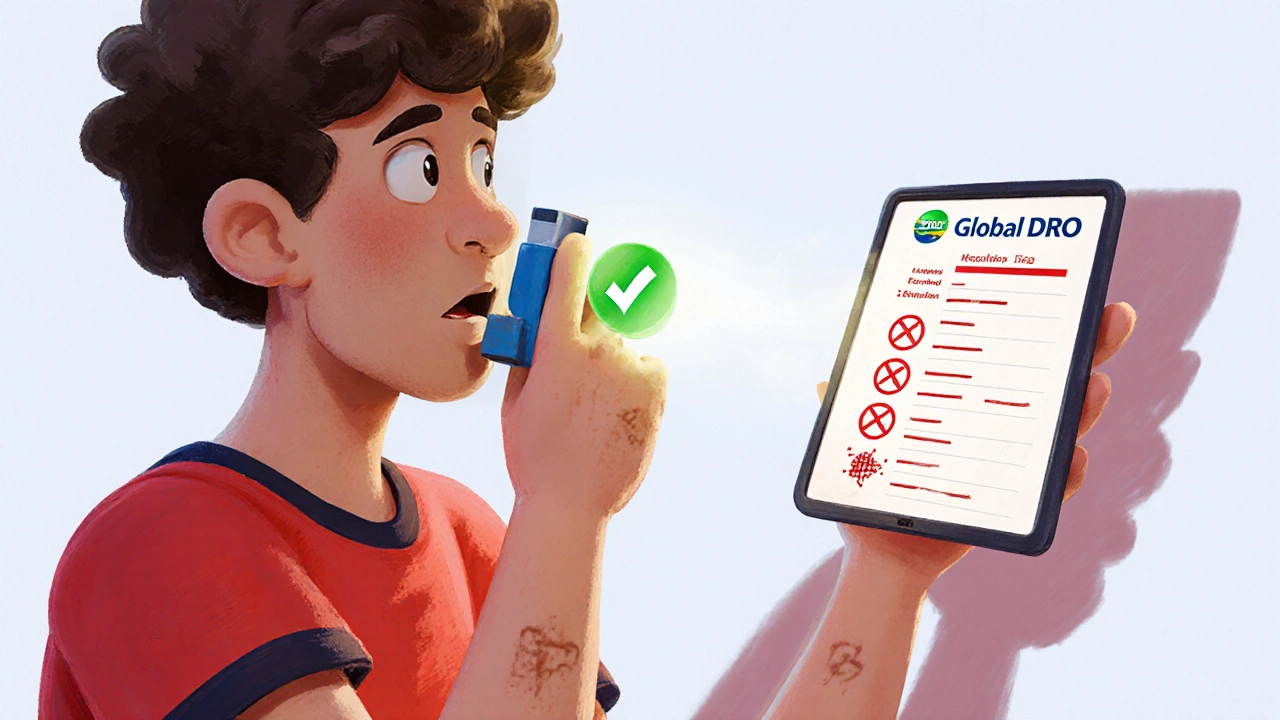Medication Safety Checker for Athletes
Check Your Medication
Enter the name of your prescription or over-the-counter medication to see if it's permitted under WADA rules.
Result
Every year, thousands of athletes take prescription meds for asthma, ADHD, diabetes, or chronic pain-medications that could accidentally land them in hot water with anti-doping authorities. It’s not about cheating. It’s about not knowing that the pill, inhaler, or injection they’ve been using for years is banned in sport. And that’s the problem: anti-doping rules don’t care if you didn’t mean to break them. You’re responsible. Always.
What You Can’t Take (Even If It’s Prescribed)
The World Anti-Doping Agency (WADA) updates its Prohibited List every year. The 2024 version lists over 250 substances banned in sport. Some are banned all the time-like anabolic steroids or growth hormone. Others are only banned during competition, like certain asthma inhalers or stimulants. The catch? A medication your doctor prescribes for you might contain one of these. And if it does, you’re in violation-even if you’ve used it for years without issue.Take salbutamol, the common ingredient in asthma inhalers like Ventolin. It’s allowed-but only up to 1,600 micrograms over 24 hours when inhaled. Go over that, or use it via injection or nebulizer, and you’ve broken the rules. Same with corticosteroids. If you’re taking prednisone for inflammation, you can’t use it in the days leading up to competition without a Therapeutic Use Exemption (TUE). These substances can clear your system in 48 to 72 hours, but if you don’t plan ahead, you’ll test positive.
Therapeutic Use Exemptions (TUEs): The Only Legal Way Out
If you need a banned medication for a real medical condition, there’s one path: a TUE. But it’s not a form you fill out the day before a race. It’s a process. You need proof. Medical records. Lab results. A diagnosis from a specialist. And you have to apply before you start taking the drug.WADA’s rules say a TUE can only be approved if four things are true:
- You have a documented medical condition that requires the banned substance.
- The medication won’t give you an unfair advantage-it just helps you return to normal health.
- No permitted alternative exists.
- You applied before using it (unless it’s an emergency).
Glucocorticoids (like prednisone) make up nearly 29% of all TUE applications. Asthma meds are second at 21%. Growth hormone is third. These aren’t edge-case cases-they’re common. But approval isn’t guaranteed. In 2022, nearly 22% of initial TUE applications were denied, mostly because the paperwork was incomplete. One athlete spent 11 months getting approved for Adderall. Another had to resubmit three times just to prove their insulin needs were legitimate.
Doctors Don’t Always Know the Rules
Here’s the scary part: your doctor might not know what’s banned. A 2022 study found that 68% of physicians treating athletes had no idea about WADA’s Prohibited List. That’s not their fault-they’re not trained in sports medicine. But it’s your problem.Don’t just hand your prescription to your GP and say, “Is this okay?” Ask them to check. Use Global DRO. Bring a printout of the WADA list. Tell them you’re an athlete. Many doctors still think “if it’s prescribed, it’s safe.” That’s not true in sport.
Physicians in British Columbia are now required by their medical board to consult the Prohibited List before prescribing to athletes. But that’s not the norm everywhere. In the U.S., only 11% of doctors treating athletes regularly check WADA’s site. If your doctor doesn’t know, you have to teach them-or find someone who does.

Side Effects You Can’t Ignore
Even if you get a TUE, the meds themselves can hurt you. Corticosteroids suppress your adrenal glands. Long-term use can lead to fatigue, mood swings, and even adrenal crisis if you stop suddenly. Beta-2 agonists like salbutamol can cause heart palpitations, tremors, or dangerous spikes in heart rate-especially when combined with training stress.Stimulants like methylphenidate (Ritalin) or amphetamines (Adderall) can improve focus, but they also raise blood pressure and increase the risk of heat stroke during intense exercise. And if you’re diabetic and using insulin? You’re not just managing blood sugar-you’re managing a substance that can trigger a positive test if you don’t have a TUE. One swimmer in 2023 had to adjust his insulin timing and dosing based on competition schedule, all under TUE supervision.
Side effects aren’t just medical-they’re competitive. If your meds make you jittery, tired, or nauseous, you’re not performing at your best. A TUE lets you use the drug, but it doesn’t fix the trade-offs.
Global DRO: Your First Line of Defense
You don’t need to guess. You don’t need to rely on your pharmacist’s memory. Use Global DRO. It’s free. It’s updated daily. It covers over 1,200 medications across 10 countries, including the U.S., U.K., Canada, and Australia.Here’s how it works:
- Go to globaldro.com
- Select your country (e.g., United Kingdom)
- Choose your sport (e.g., Track and Field)
- Type in the exact name of the medication (brand or generic)
- Check the result: “Permitted,” “Permitted with restrictions,” or “Prohibited.”
If it says “Permitted with restrictions,” note the limits. For salbutamol, it’s 1,600 mcg in 24 hours. For caffeine, it’s 12 micrograms per milliliter in urine-way above what you’d get from coffee. But if you’re taking a supplement with caffeine pills? That’s a different story.
Don’t trust labels. Don’t trust “natural” claims. Don’t trust “my friend uses this.” Global DRO is your only reliable source.
What Happens If You Get Caught?
A positive test isn’t always a four-year ban. It depends. First-time offenders with no intent to cheat might get a warning or a short suspension. But if you lied on your TUE application, hid meds, or used a banned substance without checking, the penalties get serious.WADA’s rules say you’re automatically guilty if the substance is found in your sample. No excuses. No “I didn’t know.” In 2022, 42% of athletes who tested positive said they didn’t realize the medication contained a banned ingredient. That’s not a defense-it’s a failure to check.
Sanctions range from:
- Warning (for minor, first-time cases with full cooperation)
- 1- to 2-year suspension (most common for unintentional use)
- 4-year ban (for intentional use, falsified TUEs, or repeat offenses)
And it’s not just your competition. Your sponsorships, scholarships, and future in sport can vanish overnight.

What About Recreational Athletes?
You don’t have to be an Olympian to be tested. If you’re registered with a national federation-whether you’re a college runner, a triathlete, or a high school athlete in a sanctioned league-you’re subject to the same rules. USADA and UKAD test athletes at all levels. One 16-year-old swimmer was tested at a regional meet. She had a TUE for asthma, but forgot to carry her approval letter. She got flagged. Took weeks to clear it.Parents often panic. They think, “If my kid needs insulin, should we stop it?” That’s dangerous. Don’t stop meds. Get the TUE. The Recognize to Recover program found that 28% of youth athletes stopped taking necessary medications because they feared a positive test. Their health suffered. Their performance suffered more.
How to Stay Clean and Healthy
Here’s your action plan:- Check every medication-even over-the-counter-on Global DRO before you take it.
- Tell your doctor you’re an athlete. Ask them to verify the substance against WADA’s list.
- If it’s banned, apply for a TUE at least 30 days before competition. Don’t wait.
- Keep copies of your TUE approval. Carry it with you to events.
- Know your clearance times. If a drug is banned in-competition, stop using it 3-7 days before, depending on the substance.
- Don’t trust supplements. Even “natural” ones can contain banned stimulants or steroids.
There’s no shortcut. No loophole. No “everyone does it.” The system is strict, but it’s designed to protect your health and your career. If you take the time to do it right, you don’t have to choose between being healthy and being competitive.
What’s Changing in 2025?
WADA is pushing for better integration of anti-doping info into pharmacy systems. By 2025, some countries will require pharmaceutical labels to show WADA status-just like allergy warnings. Pilot programs in Europe have already cut inadvertent doping cases by 45%.More NADOs are offering online TUE portals with live status tracking. UKAD’s Clean Sport Hub lets athletes upload documents and see their application progress in real time. USADA’s Athlete Express platform now includes video tutorials on how to fill out forms correctly.
The goal? Reduce medication-related violations by 30% by 2027. That means better education, better tools, and more support for athletes who need treatment.
But until then, the responsibility is yours. Check. Ask. Apply. Document. Don’t assume. Don’t hope. Do the work.
Can I use my asthma inhaler during competition?
Yes, but only if it’s inhaled salbutamol and you don’t exceed 1,600 micrograms in 24 hours. Other forms-like nebulizers or injections-are banned at all times. Always check your specific brand on Global DRO, as some inhalers contain other substances that aren’t allowed.
Do I need a TUE for insulin if I have diabetes?
Yes. Insulin is a prohibited substance under WADA’s S2 category (Peptide Hormones, Growth Factors, and Related Substances). Even if you’re using it for medical reasons, you must apply for a TUE before competing. Many athletes with type 1 diabetes successfully use insulin under TUE with proper documentation from their endocrinologist.
What if I take a medication and forget to check it?
You’re still responsible. Ignorance isn’t a defense under anti-doping rules. If a banned substance is found in your sample, you could face sanctions-even if you’ve used the medication for years. Always check before use. If you’ve already taken it, contact your NADO immediately. They may advise you on next steps, including possible TUE retroactivity in emergencies.
Can I use over-the-counter cold medicine?
Some can. Many contain pseudoephedrine, phenylephrine, or dextromethorphan-substances that are banned in-competition above certain thresholds. A common cold tablet might have 30 mg of pseudoephedrine, which exceeds the limit. Always check every OTC product on Global DRO, even if it’s labeled “natural” or “non-drowsy.”
How long does it take to get a TUE approved?
For international athletes, it usually takes 21 days. National-level athletes may get a decision in 10-14 days. Emergency TUEs can be processed in 72 hours. But if your paperwork is incomplete, it can take months. Apply early. Submit all required documents-medical history, lab results, specialist letters. Missing one piece can delay approval by weeks.
What happens if my TUE is denied?
You can appeal. Most denials happen because of insufficient medical evidence, not because the condition isn’t valid. Work with your doctor to strengthen your application. Provide more detailed records, additional test results, or a letter from a specialist. If you’re still denied, you can appeal to your country’s anti-doping tribunal or WADA’s TUE Committee.
Are dietary supplements safe?
No. Supplements are not regulated like prescription drugs. One in five contains a banned substance not listed on the label. Even if it’s sold in a pharmacy or labeled “tested,” it’s not guaranteed. WADA doesn’t certify supplements. If you need a supplement, look for NSF Certified for Sport or Informed-Sport logos. But even those aren’t 100% foolproof. When in doubt, skip it.

